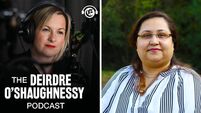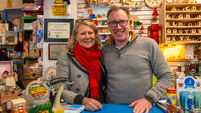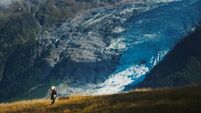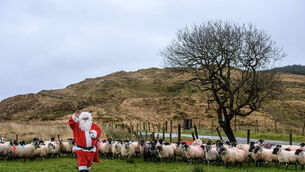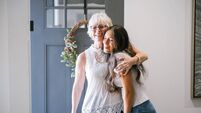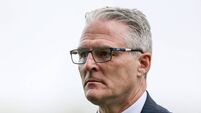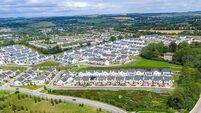KIERAN O’CONNOR
For months, it seemed that every email I received contained the phrase, ‘in these strange times’. It might as well have been ‘in these end times’, as the news from outside became bleaker.
I am old enough to remember the Chernobyl nuclear catastrophe. The heroism of our doctors and nurses (and others) reminded me of the suicidal bravery of the Chernobyl liquidators, in their improvised masks and fighting a deadly toxin: An invisible miasma sweeping in from the east, for which we had no defence. That many of us were required to do little more than sit on our sparkling-clean hands only added to the dread and strangeness.
The Covid-19 front line popped up in all kinds of places. In my house, it ran through a desk just outside my bedroom, where my wife spent days and nights online, working with her educator colleagues to reconfigure her corner of the educational system, rewrite course modules and marking schemes, and look out for the wellbeing of hundreds of students.

My creative work came to a halt. I had a few residual projects to finish before things dried up, which I attempted to work on after ‘school’. Apart from one project, of which more anon, I produced little of note; I could only look on with admiration and envy while musicians, actors, and artists started to perform and exhibit an extraordinary body of online work, while learning how to reconnect with audiences in a new way.
Our artists, it became clear, were as important as any other frontline workers. They rallied the troops; they comforted the afflicted; they boosted morale and educated our children. Artists should be paid — not as much as brain surgeons, perhaps — but at least something approaching a living wage. The success of the pandemic unemployment payment, in maintaining social stability, demonstrated that paying people to do nothing was not, after all, such a bad thing. Perhaps the universal basic income — not just for artists, but for everyone — is an idea whose time has come.
As a designer, I occupy an in-between place. What I do, by and large, isn’t art, but it is undeniably creative and many of my clients are themselves artists or art organisations.
I am part of the creative ecosystem. This ecosystem is threatened like never before and I feel it directly: Economically, emotionally, and spiritually. Empty billboards vacantly staring at shuttered streets are a personal affront. I should have been designing the posters that should have been there; I should have been going to the shows that should have been advertised.
I should have been with my people, as should you: Sharing the music, the colour, and the sublime magic of the arts. Instead, I was playing schoolteacher and failing at my sourdough starter. Of course, I’m one of the lucky ones.
I collaborated on one worthwhile project during the first wave of the virus: The Creativity Tonic
(creativitytonic.ie). This website, supported by Cork Institute of Technology-Crawford College of Art & Design, is an online compendium of creative and mindful resources gathered from around the world, intended to nourish and sustain us in times of crisis.
What if we considered a healthy imagination vital to our health? That is the question asked on the website. If there’s one thing that the lockdown has taught us, it’s that we rely utterly on the arts to make sense of the world, to escape from it, and to make it anew.
- Kieran O’Connor is a graphic designer.
CLIONA MAHER
I heard about the school shutdown on March 12, as I was uploading my Arts Council application for the 2021 festival. My neighbour was picking my son up from school and texted me to let me know.
We chatted about how they might be kept out until after the Easter holidays, and about how we might both have to work from home for a while.
I had been looking forward to getting back to the 2020 programme and to giving it my full attention, as we were producing two original theatre productions. We had already released our early events brochure and had started pre-production on the shows.

The unravelling that followed is a bit of a blur. The following week, once things started to really shut down, it became apparent that the plans for the festival would have to change dramatically, as there wouldn’t be enough time for the typical pre-festival preparations.
I talked to a lot of other festival directors and it was great to have that sense of solidarity. The first ‘replanning’ with the production manager involved doing a small number of ‘placeholder’ events at the time of the festival, and doing a mini-festival of performing arts later in the year.
As the situation progressed, in April, we made the decision to focus our energies on July and I’m glad we did, as it has been great for the arts community and the production team to have projects to focus on, since restrictions began to be lifted.
We did a virtual spoken-word event for Poetry Day Ireland at the end of April. We invited local writers to read a poem that had inspired them during lockdown. Almost all came back to ask if they could read something they’d written, instead.
It was a really great event, and we currently have an installation of quotes in Clonmel, as well as a poetry pamphlet of those lockdown works. But, technically, it was horribly stressful, as the live component crashed.
The replanning continued throughout May and June — we had an arts trail planned and had thought that the museum and arts centre would both be open in July, but the delay in the reopening roadmap put paid to that. We adapted and got permission from local owners to use their spaces, instead.
About two weeks before the festival, the phases changed again and it would have been possible to do something physical, but the announcement came too late for us to change plans again.
The last few weeks before the festival, as well as the festival itself, felt very much like the real thing — the whole team was overworked and overcaffeinated.
Our audiences were online, rather than in the room with us, but we’re very proud of having pulled it off and delivered a version of the 2020 festival that gives a good sense of Clonmel Junction Arts Festival.
- Cliona Maher has over 25 years’ experience working in the arts in Ireland, the US, and France. She has worked as an arts manager, as a theatre practitioner, and extensively in outreach and education, as both a workshop facilitator and programme co-ordinator. She took over as artistic director of Clonmel Junction Arts Festival in April 2019. A Gaiety School of Acting graduate, she has a master’s in modern drama studies from University College Dublin. She is a board member of South Tipperary Arts Centre and Finding A Voice concert series.
ANNE BODDAERT
Looking back is something I usually enjoy; remembering all the wonderful exhibitions and projects I have had the immense pleasure and privilege to be involved with in the gallery is such a blast.
Last year, our Learn and Explore programme transformed one gallery into an immersive experimental play space. Through collaboration with many artists, and in association with Dowtcha Puppets, Cork Printmakers, Graffiti Theatre Company, and Cork Film Festival, the gallery was a noisy hive of activities, encouraging creativity through playing, touching, and making. We challenge ourselves and our audiences!

A year later, the challenge is of a different nature. We can no longer take any of these tactile-based activities for granted, we have been navigating unknown territories, and have had to reimagine how to engage with the diversity of our audiences, and the variety and complexity of the artwork that the gallery holds.
Can we provide safe spaces to feed the imagination and where creativity is valued? How can we continue to tap into the incredible potential of the team of artists who have been so generous to the Crawford Art Gallery over the years?
I can’t name here all the artists who have contributed (and will continue to contribute) to our online activities over the last few months. Please go have a look at our website; there is bound to be something to intrigue, amuse, or interest you (crawfordartgallery.ie/learn-explore-home-page/).
In July, we hosted our first-ever online animation summer camp for kids. Watching the many animations that the young participants made, under the assured guidance of artist, Julie Forrester, is indeed heart-warming and smile-inducing.
We have had warm responses to artist Gillian Cussen’s videos, too. Gillian has been running our creative programme, Lonradh. When she couldn’t meet participants here in the gallery, she imagined a series of videos from her garden and polytunnel, with a warm invitation to look and enjoy the moment and meet her cats, chicken and all.
And what’s next? An activity book, based on work from the collection, is nearly ready to go to print. We want to make it widely available to audiences we may not reach online.
We are working with the Art Teachers’ Association of Ireland to make the gallery more accessible, and useful, as a teaching tool. With Expulsion, by Kevin Gaffney, and Invisible Light, by School of Looking, the two exhibitions opening in the autumn, we are continuing to research in mediating the exhibitions both for our on-site visitors and through our website.
I think Crawford Art Gallery is really a gem in Cork City centre. Please come and see for yourself.
- Anne Boddaert is curator of exhibitions, and Learn and Explore programme manager, at Crawford Art Gallery, Cork. In her role as programme manager of the Learn and Explore department, Anne’s passion is presenting projects that allow for a diverse range of voices, intelligences, life experiences, and modes of expression.
MYLES O’REILLY
My first experience of education was a Montessori school, where I spent eight years of my life drawing cartoons at the back of the class. Maths, English, Irish, history, and such, were just words coming from the teacher’s mouth, echoing through the room and partially reaching my ears, somewhat formed, but not formed enough to pique my interests.
My dear mother knew I was very enthusiastic about drawing and music, and with various teachers giving up on teaching me and sending me to the back of class to draw, my mother saw this as more of an upgrade, a special treatment for her wonderfully artistic son.
The rest of my education, until the Leaving Cert, was no different. My mother preferred I did what my heart wanted, so long as she was confident I knew what I wanted, which I did.

As a teenager, I idolised the bass player of Crowded House. He designed all the artwork for the band. Joni Mitchell, John Martyn, David Bowie all explored their relationship with expression through painting. Visual and audio, I realised very early, were intensely linked. Leaving school, I felt this knowledge was a superpower.
My heart was invincible. I joined a band. I joined several. I created the websites, posters, and artwork for all of them. Somewhere in my late 20s, I realised I was still being pushed to the back of the class, though. Society was not exactly helping me out, if I didn’t want to play a ‘serious’ role.
The music industry, it turns out, was full of business people who actually paid attention in school, and so in my early 30s, feeling the pressure to make a decent wage, save money, and pay bills, I gave up writing and recording music and picked a talent of mine that would help me ‘fit’ in.
YouTube had just begun, and everyone wanted to be on it. I had a video camera. I made one music video for someone, and someone else, and someone else, for another 10 years. Then, lockdown.
Life felt like a fast-moving train I couldn’t ever disembark. Before lockdown, five videos were under way. One idea was being formed, one video being organised, another in the middle of production, another being edited, another in the process of being released.
I’m not saying it wasn’t enjoyable being so busy, but being so productive, with just one string in my instrument of abilities, constantly felt like that one string was going to snap.
When the world stopped, initially it was tough, with my mind constantly racing ahead of itself. It took about two weeks to dust off the guitar. I asked a friend for a loan of a keyboard. Ten years of holding back suddenly poured out of me.
Four months later, I have written, composed, and recorded four albums of material and released them, one after the other, on Spotify, under the pseudonym [Indistinct Chatter]. I’m still at it, but for the whole of lockdown, every day, and because of various health reasons, which also meant I was ‘cocooning’, my time was spent in my attic, making music and drinking a hell of a lot of wine.
I’m so much happier; my mind, so much healthier. Free. Confident. Unified with conscience. I would have never have had this chance otherwise and may well have lived and died never playing all the strings in my heart.
- Myles O’Reilly is a musician, composer, and filmmaker from Dublin. Since first lifting a camera, in 2010, multi-tasking O’Reilly has filmed, directed, and edited over 100 music video promos and 20 music documentaries of Irish musicians, at home and abroad.
RAY BLACKWELL
March 9: We followed the news reports. We knew things were going to be serious, and we continued to monitor the international situation with increasing worry.
March 11: We cancelled our gigs for the upcoming weekend to the background of Cheltenham’s hype. No fucking way. It was obvious to us some sort of lockdown was imminent.
March 13: We had hand-sanitisers and signage up throughout DeBarra’s, with only staff and six customers by 11pm on the night. If I’d seen desolate tumbleweed rolling up Pearse St, Clonakilty, I wouldn’t have been surprised.

March 14: The outgoing government called a press conference, announcing lockdown from midnight. The following week was, on reflection, eerily productive. Looking back, at least there was work to do. The week was spent scurrying to the bank, talking to suppliers, reassuring staff, turning off chillers and cold-rooms, emptying fridges: Securing our business. Felt like we were digging trenches, fortifying barricades, and raising the drawbridge as the Covid-19 siege began in earnest.
March 17: St Patrick’s Day — DeBarra’s was empty.
March 19: At this stage, with all pubs/venues closed, we decided to do what we always do: Gigs. We sent the word out to artists and friends to see if they would be interested in live-streaming a show on DeBarra’s Facebook page, while the lockdown lasted.
Where we could, we attempted to honour the bookings we had in our diary, with artists booked in to play DeBarra’s now doing so from their own homes. The response from musicians, when we put it to them, was amazing. It was so reassuring.
We started our first livestream show on March 24 with Ava and Jack Archbold. They’re a brilliant local brother and sister duo, who play regularly in De Barra’s. We’ve hosted live-streams daily since then.
Artists and friends from Clonakilty, and all over the world, have performed as part of our ‘Sitting Room to Sitting Room’ sessions.
The significance and work of sound engineers, lighting technicians, physical audiences, and real venues were acknowledged for sure. But what about the shows themselves?
Some artists performed their first-ever live-stream. Our resident DeBarra’s traditional musicians, some in their 70s, performed individual live-streams, continuing a DeBarra’s tradition that goes back 30-plus years.
All the acts were wonderful, all the gigs were shows. Shit went wrong, shit went right. But, mostly, our community connected throughout the world; neighbours said hello to neighbours that they hadn’t seen in person for weeks.
We started to recognise new ‘regulars’, tuning in nightly from all over the world. Some performances were in sitting rooms, some were in gardens, some shows couldn’t go ahead, due to the virus claiming loved-ones’ lives. Around us, the Black Lives Matter movement swelled, internet connections died, beautiful hope and music lived. We all felt safe in the moment of the gig or the stream.
Paralysis, anxiety, and despair have all been part of our Covid-19 experiences. Certainly, this has been the case for me, but outside of my immediate family, I definitely found solace in the music, camaraderie in the community of musicians and music lovers, and comfort in the consistency of our gigs.
Meanwhile, we remain closed, live-streaming and kicking.
Our commitment to music and music lovers has only been reinforced, as we look forward to being able to reopen DeBarra’s safely, as soon as we are able.
- Ray Blackwell is the manager of DeBarra’s Folk Club, Clonakilty.
JOHN O’BRIEN
The sun helps. Cooking helps. The kindness of friends really helps. It’s a strange kind of grief. When I was asked to write this paragraph, thinking about the last months, I was quite overwhelmed by sadness. It took a few days before I could sit and put pen to paper.
Who I am as a person is intrinsically linked to who I am as an artist. Everything that I make involves those most dangerous of activities: Singing, dancing, large groups of people (performers and audience) huddled together in confined spaces, breathing together.
I am a conductor and director. As an artist, my medium is the group of fellow artists who have joined together to make something bigger than any one of us.

I miss those people: The beautiful, nerdy conversations — about floorplans, colours, textures, schedules, and logistics — with stage management, designers, and producers; shaping a phrase with Majella, and having to hold on tight to my technique in case the emotion, from the beauty of her singing, overwhelms me; Dave perfectly placing the bass note as my finger moves us to the next bar; a haunting wind solo from Kieran, or Sinéad, or Ciara; the energy of the full string section giving their all; the whole orchestra, and then the soloists, and then the chorus, becoming one in the space between my hands; the held breath of the audience at a particularly exquisite moment.
Listening to music on recordings is hard to do now. It often makes me sad. Or I can’t concentrate on it. And I’ve never been a fan of online, streamed theatre or opera. It all just highlights to me what is absent.
As the great director Peter Hall says in the book Exposed by the Mask, “Videos and films of either of them (opera and theatre) are good adverts, good bits of PR for the real thing. But they are like reproductions of famous paintings ... they are far from being the thing itself.”
2020 was going to be a good year: Eight concerts with our beautiful Cork Opera House Concert Orchestra; curating and conducting a trilogy of operas with the Everyman for a national tour; The Proms and Chitty Chitty Bang Bang all summer at the Opera House; and a tour with Karen Underwood of the new album we made.
All of these projects involved between six and 18 months of planning and personal investment. Some of them could possibly happen in the future. Some can’t, as a good portion of the funding was already spent.
I am trying to imagine future projects. I am fighting for ideas to be developed next year, and hope that things will be possible then. I hope the Government does its best to protect our very fragile arts sector, and fights to save the existing infrastructure, for when it might be possible to return.
I’m hoping the Government’s €350 Covid-19 payment continues, as I’ll be totally screwed without it. For now, there is the sun (when it comes out), food, television on the laptop in bed, friends, and love.
- John O’Brien is a conductor, director, and composer based in Cork.
EDEL CURTIN
The lockdown has been an emotional rollercoaster. The first few weeks were about getting our heads around what was actually happening: How bad was this virus going to be? Would our loved-ones get sick? If they did, would they recover? Is this really happening?
After coming to grips with that, my attention turned to our business. It took a while for the reality to hit; it still doesn’t seem real, four months on. It became obvious that we would be shut for the foreseeable future, something I never thought I would see happening.

We’ve tried to stay positive, but it hasn’t been easy. Our industry is really, really struggling. Everything about our business is social, so to try to reimagine that is going to be challenging, but with the proper supports, I do believe we can do it.
We’re lucky that we have a lovely beer garden in Coughlan’s, so, hopefully, when we are allowed to reopen, people will feel comfortable, knowing they can sit outside if they wish.
I also spent some time over lockdown working with a local software engineer on a booking system for the bar, called ‘pub pass’, so we also have that in place for reopening.
Brian Hassett, who is my business partner in Coughlan’s Live Promotions, spent a lot of time on the ‘Troubadours at Home’ series, where we hosted online concerts with some of the many musicians who have played Coughlan’s down through the years.
One of our regulars, Robbie, set up an online quiz night for the staff, which we all took part in every Friday night and we also kept in touch with lots of the locals and regulars, so we’ve held on to a lot of those important connections we’ve built over the years. Besides that, it’s difficult to know what else to do, until we’re given the green light and guidelines to reopen!
A positive to come out of this, though, has been having so much time with my fiancee, Lee, and our beautiful little daughter, Saoirse.
She’s almost two, so it’s been a great time for both of us to be home with her — she’s made it a lot easier and is a constant source of entertainment!
I hope other people have found some sort of silver lining, or positivity they can take from all of this, too. It has been an extremely tough time for everyone, but I do believe we’ll come out of it stronger, it’s just a question of when.
- Edel Curtin is the proprietor of multi-award-winning music venue, Coughlan’s, on Douglas Street, Cork. A musician, Edel took over Coughlan’s in 2012. She is also a director of Coughlan’s Live Promotions, who are programming the new Ballycotton venue, Sea Church, as well as putting on other events and shows in Cork and around the country.

Subscribe to access all of the Irish Examiner.
Try unlimited access from only €1.50 a week
Already a subscriber? Sign in
CONNECT WITH US TODAY
Be the first to know the latest news and updates




